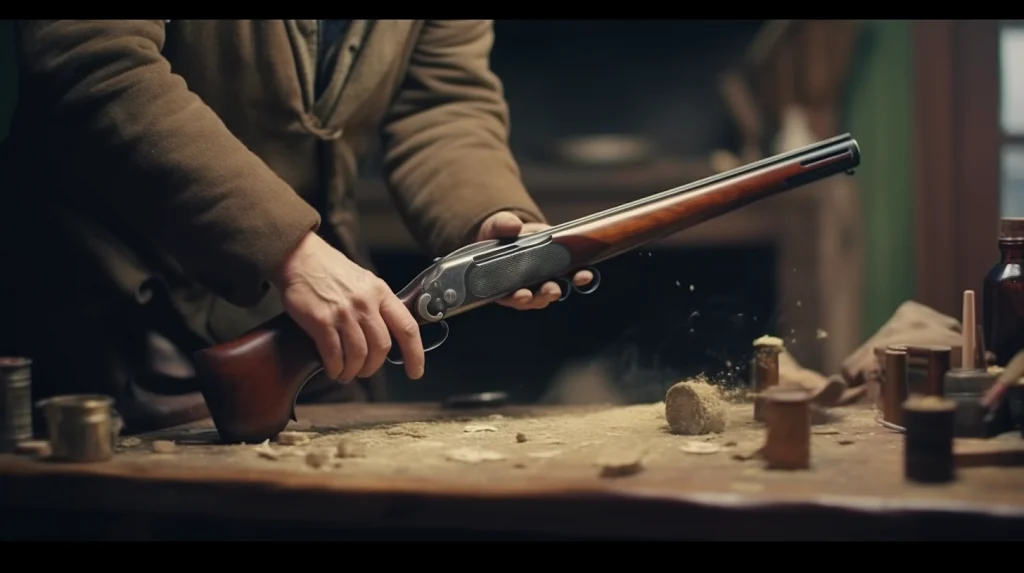
Table of Contents
Regular cleaning is essential to maintain the performance and longevity of your shotgun. Proper cleaning removes dirt, residue, and debris that can accumulate over time, ensuring smooth functioning and reliability. In this step-by-step guide, we will walk you through the process of cleaning your shotgun, covering barrel cleaning, action and receiver cleaning, lubrication, and reassembly. Let’s get started and learn how to clean your shotgun effectively.
Before cleaning your shotgun, it’s important to follow these safety precautions:
To clean your shotgun, gather the following supplies:
Before cleaning, familiarize yourself with your shotgun’s manual to understand the field stripping process. Disassemble the shotgun as instructed, separating the barrel from the action and receiver. This will allow for easier access to different parts for cleaning.
Follow these steps to clean the shotgun barrel:
Follow these steps to clean the shotgun’s action and receiver:
Proper lubrication is crucial to ensure smooth operation and protect against rust and corrosion. Follow these steps to lubricate your shotgun:
Carefully reassemble the shotgun according to the manufacturer’s instructions. Ensure all parts are properly aligned and secured. Check that the action functions smoothly and that the shotgun is fully operational.
After cleaning, consider the following tips for storing your shotgun:
Regular cleaning and maintenance of your shotgun are crucial for optimal performance and longevity. By following these step-by-step instructions, you can effectively clean your shotgun, ensuring it remains in top condition. Remember to prioritize safety, use appropriate cleaning supplies, and consult your shotgun’s manual for specific instructions. With proper care and maintenance, your shotgun will continue to provide reliable performance and enjoyment for years to come.
Q1: How often should I clean my shotgun?
A1: The frequency of cleaning depends on various factors, including usage, environmental conditions, and ammunition type. It’s generally recommended to clean your shotgun after each use or at least every few months if it’s not used regularly. However, if the shotgun is exposed to adverse conditions or fired extensively, more frequent cleaning may be necessary.
Q2: Can I use any cleaning solvent and lubricant for my shotgun?
A2: It’s best to use cleaning solvents and lubricants specifically designed for firearms. These products are formulated to effectively clean, protect, and lubricate the various components of a shotgun. Follow the manufacturer’s recommendations for the appropriate cleaning products to use.
Q3: Should I clean the choke tubes separately?
A3: Yes, choke tubes should be cleaned separately from the shotgun barrel. Remove the choke tubes and clean them using a dedicated choke tube cleaning brush or cloth. Apply a small amount of cleaning solvent and scrub them thoroughly to remove any residue or fouling.
Q4: Can I use compressed air to clean my shotgun?
A4: Compressed air can be used to blow away loose dirt and debris from certain parts of the shotgun. However, it’s important to exercise caution and avoid using excessive air pressure, as it can force debris deeper into the mechanism. Additionally, compressed air should not be directed towards the barrel or sensitive components.
Q5: Do I need to clean the stock and forend of my shotgun?
A5: It’s generally not necessary to clean the stock and forend unless they are visibly dirty or contaminated. However, wiping them down with a clean, damp cloth occasionally can help maintain their appearance and remove any surface dirt or grime.
Hunting laws can be complex, especially when firearms intersect with archery. While bowhunting focuses on…
Kayaking is a fantastic way to explore waterways, enjoy the great outdoors, and get a…
Wild turkeys are fascinating creatures known for their distinctive vocalizations. Understanding these sounds can enhance…
Raising a hunter is an endeavor filled with rich experiences and invaluable lessons. Whether you're…
Trail running is an exhilarating way to combine fitness with the beauty of nature. Unlike…
Introduction Hunting is a physically demanding activity that requires strength, endurance, and agility. Being physically…
This website uses cookies.